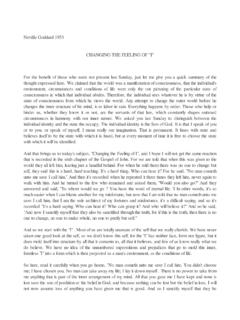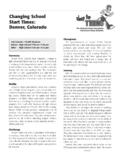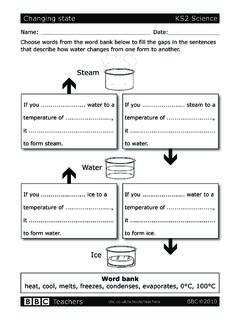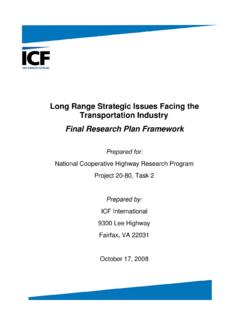Transcription of SPRING 2013 - United States
1 1 FIRST ANNUAL REPORT BY THE supply chain MANAGEMENT FACULTY AT THE UNIVERSITY OF TENNESSEESPRING 2013 GAME- changing trends IN supply CHAINSPONSORED BY12 CONTRIBUTORS:TED STANK, AUTRY, BELL, DAVID GILGOR, PETERSEN, DITTMANN, MOON, TATE, BRADLEY, ANNUAL REPORT BY THE supply chain MANAGEMENT FACULTY AT THE UNIVERSITY OF TENNESSEE SPRING 2013 GAME- changing trends IN supply chain SPONSORED BYTEN GAME- changing trends IN supply chain FOUR KEY AREAS OF COMPETENCYGAME CHANGERS32 ATABLE OF CONTENTSI ntroduction 3 Customer Service to Customer Relationship Management 5 Adversarial to Collaborative Relationships 10 Incremental Change to a Transformational Agile Strategy 14 Functional Focus to Process Integration 19 Absolute Value for the Firm to Relative Value for Customers 25 Forecasting to Endcasting (Demand Management) 31 Training to Knowledge-Based Learning (Talent Management) 36 Vertical Integration to Virtual Integration 41 Information Hoarding to Information Sharing and Visibility 45 Managerial Accounting to Value-Based Management 49E very month a new article or conference lecture seems to present a fresh idea about the game- changing trends faced by supply chain professionals.
2 Consulting companies, academics, and even individual companies have their own opinions about and definitions of supply chain megatrends. Often these mega- trend lists do not match; instead they reflect the backgrounds and experiences of the people who compile them. For this white paper, we define game- changing trends as those trends that meet the two basic criteria of being extremely impactful on a firm s economic profit and shareholder value, as well as very di!cult to implement 10 game- changing trends discussed in this white paper have their foundations in a 2000 landmark study co-authored by Ted Stank on our faculty. That study and the updated version incorporated responses from approximately 150 supply chain professionals across a wide range of industries (retailers, manufacturers, and service providers, large and small in size). But that doesn t mean the material in this white paper is dated far from it.
3 Based on our interaction with literally hundreds of companies annually (the largest industry network in the academic world), we believe that those trends still serve as a foundation. But the supply chain world has drastically changed over the past 13 years. In this white paper, we ll discuss the game- changing supply chain trends that you need to squarely face today, and we ll suggest how to make progress toward the desired end state. We ll also use plenty of examples along the a student asked Albert Einstein if this year s physics exam questions were the same as the previous year s, he responded, Yes, but unfortunately for you the answers are very di!erent. Our game- changing trends are like those questions. We still see some of the same supply chain trends , but the real world responses to them are dramatically more sophisticated. A GAME CHANGER changes the way that something is done, thought about, or made.
4 Henry Ford was the epitome of a game changer. His revolutionary new mass-production methods, including the world s first moving assembly line for cars, made automobile ownership affordable for many middle-class trends IN supply chain INTRODUCTION 54 GAME- changing trends EVOLUTION Firms have made significant progress in the last decade in each of the ten members of our supply chain management faculty collaborated to identify 10 game- changing trends and then write this document. The 10 trends align perfectly with the research of these faculty members. (The University of Tennessee is ranked No. 1 in the world in supply chain management research.) And we tapped our wide ranging experience with industry leaders through our global forums, executive education, and document will give you a brief synopsis of today s leading thinking about 10 game- changing trends in supply chain :1. Customer service to customer relationship management2.
5 Adversarial relationships to collaborative relationships 3. Incremental change to a transformational agile strategy 4. Functional focus to process integration 5. Absolute value for the firm to relative value for customers 6. Forecasting to endcasting (demand management)7. Training to knowledge-based learning 8. Vertical integration to virtual integration 9. Information hoarding to information sharing and visibility10. Managerial accounting to value-based management In the last two months of 2012, over 160 supply chain professionals were surveyed to assess these 10 trends in industry, as well as how those trends have changed. While they will be expanded in the body of the white paper, below are some highlights of that survey:Q Firms have made significant and in some cases surprising progress in the last decade and in each of the 10 Some companies have achieved top levels of performance in individual categories, although no firm has excelled in all categories.
6 Thirteen years ago, no one reported a top level of performance in any There are laggards in each category as well. These firms appear to be fighting the same battles in the same Respondents feel that most progress has been made in customer relationships and cross-functional integration. Firms seem to be better focusing on their customers outside the firm and shoring up the emphasis on cross-functional processes inside the Ta l e n t m a n a g e m e n t c l e a r l y e m e r g e s a s t h e l i n c h p i n r e q u i r e d f o r a d v a n c e m e n t i n a l l a r e a s .The remainder of this white paper is divided into 10 sections, one for each trend. We ve used the survey information as one input but also included the leading edge thinking from all of our research and industry J. Paul Dittmann1 Don Bowersox, David Closs, and Ted Stank; Ten Mega trends That Will Revolutionize supply chain LogisticsGAME- changing trends IN supply chain INTRODUCTIONCH NGEG MEAWHY IS THIS A GAME- changing TREND?
7 Customer relationship management remains a game changer for all companies because it requires customer prioritization to maximize revenue and profitability by targeting limited resources. Few would disagree that this needs to be done; yet we find that few companies actually create customer focused, differentiated supply chain plans. This requires tough choices that are sometimes unpopular and often engulfed in politics. But a few leading firms have truly embraced this game- changing trend that is gathering momentum. One medium sized retailer, a member of our supply chain Forum, survived the Great Recession by focusing on critical customers. They confirm that this segmented customer focus was the crucial element in a strategy that allowed them to take out 48% of their inventory while still improving on-shelf availability from 96% to SERVICE TO CUSTOMER RELATIONSHIP MANAGEMENT BY TED STANK, Harry J. and Vivienne R.
8 Bruce Chair of Excellence in BusinessServe all customers the same without focusing on their specific needs 10 12012 ( )2000 ( )CUSTOMER SERVICE TO RELATIONSHIP MANAGEMENTP artner with key customers to provide value-added services and service levels Customer relationship Customer 2000 LEVEL ONE LEVEL THREE LEVEL TWO76 PROGRESS MADE BUT MORE NEEDEDWe have come a long way as a profession by changing our focus from merely providing excellent customer service to actually managing relationships with targeted customer segments. What will it take to reach the next level in managing customer relationships? Before answering that, let s reflect on the progress the 2000 landmark study referenced above, the authors noted that the customer service to relationship management trend was one of the most advanced game- changing trends .
9 On a scale of 1 to 10, with 10 being total adoption and 1 representing no meaningful acceptance, it had achieved a 5-6 level of maturity. The prediction was that by 2010, organizations would be operating close to the total adoption level, a score of 10. The research supporting this white paper suggests that industry has continued to improve on this trend, although most organizations still have not achieved total maturity. The aver-age among the firms responding to the 2012 survey was , with a range (at one standard deviation) of to The important takeaway is that while some leading firms have pushed close to total adoption, a significant number of organizations may be considered laggards in adopting this game- changing FIRMS STILL OPERATE WITH A TRADITIONAL SERVICE MINDSETThe traditional approach to customer service was standardizing service for all customers. The original study showed that many firms operated from a traditional service mindset while industry had progressed toward managing each customer or customer segment as a unique service relationship.
10 It should be noted that by understanding true Cost-to-Serve of a client/product segment, a company can more effectively allocate/charge for the services recognized that supply chain performance on dimensions like in-stock availability and on-time delivery were critical to the buying process. Thus they developed standard operational capabilities to facilitate standard and uniform levels of service delivery to all customers. With that focus, achievement of internal performance goals and targeted operating standards were indicators of success ( , on-time delivery, shrinkage levels, num-ber of customer complaints, etc.).FROM A HIGH LEVEL OF STANDARD SERVICE TO CUSTOMIZED SERVICEI mproving operational effectiveness for all customers is, of course, highly desirable and may be considered a building block toward gaining competitive advantage. However, business success derived from a focus on stan-dard levels of service effectiveness is usually short-term at best.
















